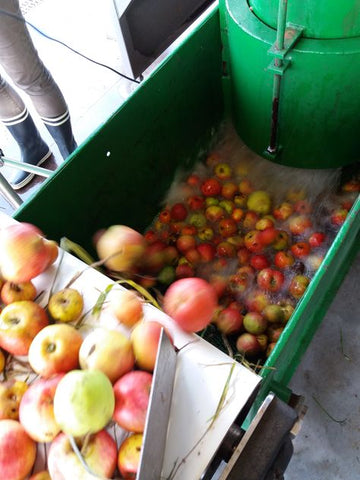The revival of artisanal cider
Carried by a whole new generation, the world of cider knows a very beautiful dynamics and a true revival.
In the collective imagination, cider is often seen as a second-rate and very cheap drink, consumed in bowls in pancake houses. But today, it is finally beginning to be recognized for its true value: elegant, greedy, complex and it has its place in the cellars of the most curious tasters.

@Antoine Marois
In fact, we should talk about natural fruit sparklers if we wanted to correctly describe all the drinks that are at the origin of this revival. Pears, but also more original fruit associations like at Lo Gano De Combrailles with CFC a cider blended with a co-fermentation of red currant and rhubarb, or the talented Antoine Marois and his Renard a grape cuvée born from a maceration of pineau d'aunis marc during fermentation.
In short, there is really something to drink! Here, we'll explain how cider is made and why, and how some people have challenged themselves to put it back where it belongs.
Reasons for the revival:
The apple offers a wide, very wide diversity. There are more than 10,000 varieties, and wild apple trees can be found in many parts of the world. Some enthusiasts have chosen to explore the terroir dimension.
Small technical point: there are 5 categories of cider apples:
- The sweet ones : very sweet, they bring greediness and roundness
- Bitter-sweet : more sweet than bitter, they bring structure
- Bitters: rich in tannins, they form the framework of the cider, accentuating its bitterness and astringency
- Acidulous : they generate freshness for their quiet acidity
- The sour : they give vivacity and accentuate the aromas by their marked vivacity
Source: Le Journal du Sommelier, Fall-Winter #1, Cider
Therein lies the talent of the cider maker! Finding the right varieties, the right blends to achieve the right balance.
But what all varieties have in common is that they must be harvested when they are ripe in order to get the best profile. Moreover, our modern cider growers, those who come to shake up the environment, work to collect the apples on the ground, once their maturity has allowed them to fall from the tree. They also encourage grassed orchards, intended to protect the fruit when it falls.
 @Antoine Marois
@Antoine Marois
A new wave of producers ... and consumers!
There is a whole fringe of ambitious producers who want to restore the image of cider. Some of them are coming from reconversion, already know the freer and more open spirit that can be found in natural wine and craft beer and wish to bring cider into the movement.
They wish to make cider a modern drink thanks to techniques such as spontaneous fermentations, cidrifications in barrels or in amphoras, co-fermentations of fruits, ... A search for creativity and new blood!
In industrial cider, we can produce a bottle in less than a week against 8 months minimum for an artisanal cider like those we propose.
Process of the industrial cider in some stages:
- Pasteurization of the must
- Rapid fermentation with synthetic yeast
- Addition of various inputs: sugar, flavor enhancers, sulfites, acidity correctors, colorants, ...
- Foaming with CO2
 @Julien Thurel
@Julien Thurel
Some icons have participated in this revival, such as Eric Bordelet for example, who describes himself as a cider grower and winemaker, or Cyril Zangs who had originally planned to become a winemaker, then finally returned to his native Normandy to make cider, as his grandfather did. These artisans have contributed greatly to changing the image of cider, to making it a high quality drink and to giving the desire to others to start...
On the consumer side, there is also a greater demand for diversity. Drinkers are looking for taste and authenticity! Today, there are even specialized places such as La Cidrerie which has two addresses in Paris, or even Le Sistrot in Quimper.
The telescoping of two dynamics: from the respect of tradition to the punk touch
As in natural wine, for the new generation of fruit sparkling wines, the notion of terroir is strong, we can find parcel-based vintages, from very precisely located orchards.
Of course, we keep the peasant roots, the ancestral know-how, but we shake them up, diversify them. We don't want to limit the sparkling fruits to sweet or raw ciders anymore... The possibilities are much wider. And then we want a more respectful approach of nature: orchards in bio or biodynamic, no addition of chemistry, fermentations from indigenous yeasts and natural foam.
The renewal also goes through the graphic identities, through the labels. More fun, more colors, more madness!
On Buvance, you can find a selection of artisanal cider makers involved in this renewal!
Ciders, perries and sparkling fruits selected to allow you delicious discoveries.




